This is a Kowa SET-R single lens reflex 35mm camera made by Kowa Optical Works between the years of 1968 and 1970. It was the third to last model in a series of leaf shutter SLRs made by Kowa, starting with the Kowaflex from 1959. The SET-R was the first Kowa SLR with both a through the lens CdS meter and an interchangeable lens mount. Equipped with an excellent 6-element Kowa lens, the camera was extremely competitive to much more expensive cameras sold by the competition.
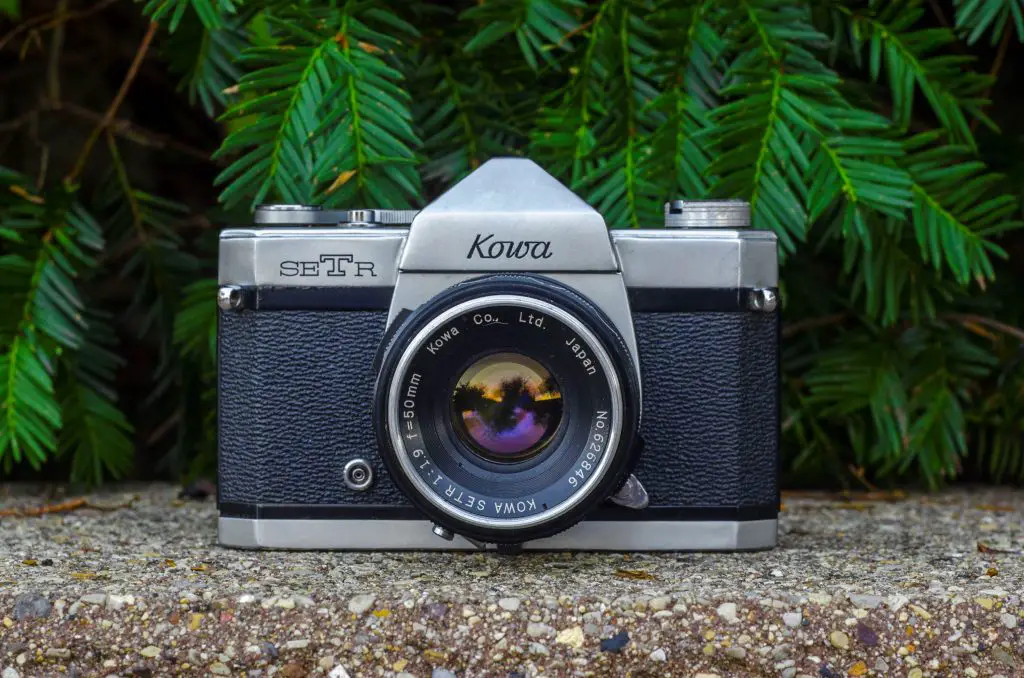 Film Type: 135 (35mm)
Film Type: 135 (35mm)
Lens: 50mm f/1.9 Kowa coated 6-elements
Lens Mount: Kowa Type R Bayonet
Focus: 2.5 feet to Infinity
Viewfinder: Fixed SLR Prism with Fresnel screen and microprism focus aide
Shutter: Seiko SLV Leaf
Speeds: B, 1 – 1/500 seconds
Exposure Meter: Coupled TTL CdS Meter with Match Needle in the Viewfinder
Battery: PX625 1.35v Mercury
Flash Mount: Clip-on Coldshoe and M and X Flash Sync
Manual: http://www.cameramanuals.org/pdf_files/kowa_set_r.pdf
My Final WordHow these ratings work |
The Kowa SET-R was one of the last leaf shutter cameras made by any company and has modern features like an interchangeable lens mount, TTL CdS exposure meter, and a really great 6 element f/1.9 lens. Although the design of a leaf shutter SLR has a poor reputation for reliability, if you can find one that works, the SET-R becomes an extremely capable camera. The control layout is familiar and comfortable, the viewfinder is large and bright, the match needle exposure system is easy to use, and most importantly, the camera produces excellent images. These cameras are not very common, and finding one in good working condition is likely difficult to do, but if one ever were to cross your path, there’s a good chance it won’t be expensive, and is absolutely worth the asking price. | ||||||
| Images | Handling | Features | Viewfinder | Feel & Beauty | History | Age | |
| 2 | 2 | 1 | 1 | 1 | 1 | 20% | |
| Bonus | +1 for the complete package, an excellent camera that is just as fun to use as it is capable | ||||||
| Final Score | 10.6 | ||||||
History
This Kowa SLR was made by a company who can trace it’s roots all the way back to a textile shop in Nagoya, Japan in 1894. This original company would go through many iterations of itself, making a variety of products that had nothing to do with cameras or the optics industry. It would not be until 1946 that the company would be split up into several different companies, one of which was Kowa Koki Seisakusho, or Kowa Optical Works in English.
Originally producing eyeglasses, Kowa Koki Seisakusho expanded it’s portfolio to include binoculars, rifle scopes, and opera glasses. One of Kowa’s first successes in the optics industry were a line of theater projection lenses called the Prominar. The Prominar series of lenses were commonly used in theaters showing anamorphic Cinemascope movies, and is still a popular brand made today.
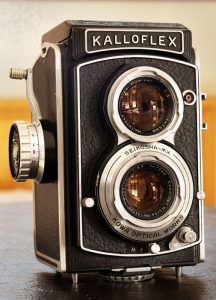
It would not be until 1954 that Kowa would produce their first film camera which was a 6cm x 6cm Twin Lens Reflex camera called the Kalloflex. The Kalloflex was positioned as a high-end Japanese TLR, and featured Kowa’s Prominar label on the lenses. Although a well built camera that was well received by photographers, it was only in production for about 4 years, at which time Kowa would focus primarily on 35mm cameras, first with a series of viewfinder and rangefinder models, but then in the 1960s with a line of leaf shutter SLRs.
The first of Kowa’s SLRs debuted in 1959 and was called the Kowaflex, and it introduced the same basic shape that would be the basis for the rest of the lineup. This first model had a fixed 50mm f/2 lens, and no meter. As each new model was released, Kowa would continue to improve upon the previous model. The first was the Kowaflex E which included a selenium cell exposure meter, but still the fixed lens. Then came the Kowa SE (the Kowaflex name was dropped) which replaced the selenium meter with a body mounted CdS meter. The SET moved the CdS meter into the prism for through the lens metering, and finally the SET-R which topped it all off with a new interchangeable lens mount. There would also be an SET-R2 released in 1970, but for the first time, no major changes were made, only cosmetic ones. The entire Kowa leaf shutter SLR series would end in 1972 with the extremely rare Kowa UW190 which had a fixed ultra-wide-angle 19mm lens.
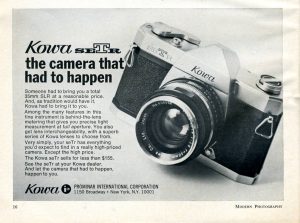
All Kowa SLRs were promoted as having the best value of any SLR camera compared to the competition. Earlier models retailed for around $130, and the ad to the right for the SET-R suggests a retail price of “less than $155”. It was typical for street prices of cameras to be below the retail price, so the prices quoted in magazine ads like this were rarely what you’d expect to pay. Even with a $155 list
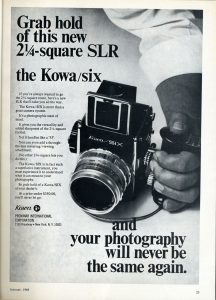
price, that compares to just over $1000 today so it wasn’t exactly pocket change.
I could not find any information about production numbers, although Frank Mechelhoff’s Kowa page suggests a number somewhere between 30,000 and 50,000 total.
Kowa was never a major player in the Japanese camera industry. Other than their leaf shutter SLRs, they had a small amount of success with their Kowa Six lineup of medium format single lens reflex cameras. The Kowa Six was marketed as a sort of “poor man’s Hasselblad”. Like Kowa’s leaf shutter 35mm SLRs, the Kowa Six had pretty good build quality and solid optics, making for a great value. Still, the cameras were only moderately successful, and by 1974, the company had completely exited the camera business.
Kowa would continue on for the next several decades making scopes, binoculars, and a wide variety of optics products. The name Kowa still exists to this day, but refers to itself as the Kowa Group. The Kowa Group’s corporate website suggests the company has their hand in a large number of industries, from LED lighting, healthcare, prescription drugs, renewable energy, textiles, and many others.
I could not find any information regarding whether the Kowa that once made bargain 35mm leaf shutter SLRs is still the same company, or if they merged with other companies to create the current group, but I guess it doesn’t really matter. What matters is that for a brief moment in the middle of the 20th century, Kowa produced a couple of different budget minded cameras that were actually quite good.
Today, Kowa leaf shutter SLRs are not in high demand. A combination of a relatively unknown brand, and a style of camera that is notorious as being unreliable and finicky likely dooms any high value these cameras might have. However, if found in good working condition, their low prices represent a huge bargain for a collector looking for something just a little different.
My Thoughts

I told myself I was done with leaf shutter SLRs, I really did. I had a few, and kept striking out every time I had an opportunity to play with one. It started with a Kodak Retina Reflex III and continued with a Kowa SE-T both of which I previously reviewed in my Cameras of the Dead series.
You see, most SLRs, even those dating back to the old medium format ones like the Kochmann Reflex-Korelle from the early 20th century, used focal plane shutters in which a fabric (or sometimes metal) curtain travels vertically or horizontally right in front of the focal plane. This type of shutter design has some advantages in that they are capable of higher shutter speeds, and always keeps light off the focal plane up until the exact moment of exposure, but they are complex to design and have slower flash sync speeds.
Leaf shutter technology had been mastered for quite some time by the time SLRs started to take off in the late 1950s and there were many companies who had a lot of experience with them, and not so much with focal plane shutters, so it made sense that these companies would have a good reason to figure out a way to use a leaf shutter in an SLR.
The biggest obstacle however, is that the “R” in “SLR” stands for Reflex (which means mirror in camera-speak) and that mirror’s job is to redirect light coming through the lens up into the viewfinder so that the photographer may compose their image through the lens of the camera. Leaf shutters are almost always attached behind a lens, or in some cases, in between some of the lens elements requiring them to be mounted near the front of the camera, well before a reflex mirror is found in an SLR.
Since an SLR requires light to pass through the lens, hit the mirror, and then travel through the viewfinder so the photographer can compose an image, you need to find a way to keep that leaf shutter and the lens iris wide open during composition. But if the shutter is open, how do you prevent the film from being unintentionally exposed? Therein lies the problem.

Leaf shutters require a complex dance of mechanical movements where the shutter remains open while the reflex mirror is down. A metal door, sometimes called a capping plate, exists behind the mirror and blocks light from exposing the film. The design of the capping plate varied by manufacturer, with some of them being an entirely separate plate and others being part of the reflex mirror assembly.
The drawing to the right comes from Frank Mechelhoff’s page “West German Cameras: How They Lost to the Japanese”. His drawing is of a Zeiss-Ikon Contaflex which is a leaf shutter camera similar to the Kowa SET-R. I drew red arrows to indicate the key parts of the diagram to help illustrate the complexity of the design.
When it is time to make an exposure, the camera must first close the shutter and stop down the iris to whatever f/stop you have selected. Next, the reflex mirror and capping plate must move out of the way to allow for light to pass through the mirror box and expose the film. With everything ready to go, the shutter is now ready to open and close at whatever speed it is set to. All of this happens quickly in the moment after pressing the shutter release, however there is still a delay of about 1/50th of a second for all of these motions to complete, which could cause problems for fast motion shots where a precise exposure must be made.
Many leaf shutter SLRs do not have an instant return mirror where the camera readies itself for the next shot, allowing light to pass through the lens, shutter, and bounce off the mirror and into the viewfinder again. The Kowa SET-R on the other hand, does have this feature, so after firing the shutter, everything must reset with the capping plate and mirror moving into the down position, and then shutter and iris reopening again allowing light to pass through.
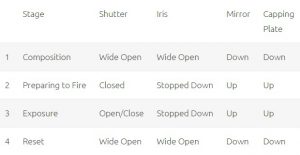
The table on the left summarizes the events that must unfold each time a photograph is taken with a leaf shutter SLR like the Kowa SET-R.
If this sounds like an overly complicated way to make an SLR, you’re right. While overall it did work, the chances for failure were higher for leaf shutter SLRs compared to focal plane SLRs due to the shutter cycling twice for every exposure taken and with the extra moving parts, there were more opportunities for things to go wrong. Even in the 1960s when these cameras were new, the cost to repair them was substantial due to their complexity, causing leaf shutter SLRs to earn a poor reputation for reliability. While I could not find any evidence of this, I would suspect that many repair shops back then might have declined service on models like these for this very reason.
For this review, I’ll spoil the surprise for you and tell you that this SET-R defied the stereotype and worked fine. Perhaps this camera was taken REALLY good care of, or maybe it was recently serviced at some point in the past, or perhaps it’s one in a million that I got lucky with and still works.
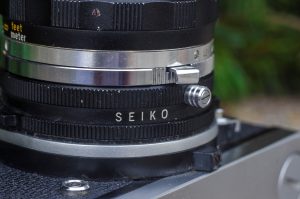
Regardless of WHY it worked, all I care is that it does work. The convoluted dance of shutters, mirrors, and backing plates opening and closing during every cycle of the shutter makes for a truly unique sound and feel. Leaf shutter SLRs make a sound that you’d never mistake for a traditional focal plane shutter. I even detect a bit more vibration of the camera each time the shutter fires, which is probably not a very good idea for macro photography or long exposures where a motionless camera is desirable. But for every day photography, the Kowa SLR works really well.
Kowa is perhaps the best known of the Japanese manufacturers to make leaf shutter SLRs, but they weren’t the only ones. Mamiya, Topcon, Minolta, Ricoh, and Nikon all released leaf shutter SLRs (although Nikon’s was just a rebadged Mamiya). The Germans liked leaf shutter SLRs as well, with models from Voigtländer, Zeiss-Ikon, AGFA, and Kodak AG available around the same time. A unique difference between Japanese and German leaf shutter SLRs was in the design and layout of the controls. The Germans would typically adapt an existing rangefinder camera to work like an SLR which caused them to have uncommon controls like the bottom wind of the Retina Reflex or the left hand wind of the VEB Pentacon Pentina. In addition to controls not being where you’d expect them, some German leaf shutter SLRs looked weird too, like the Pentina, Voigtländer Bessamatic series, and AGFA Ambiflex. Most of the Japanese leaf shutter SLRs were not inspired by an existing design, and looked pretty much like every other SLR out there.
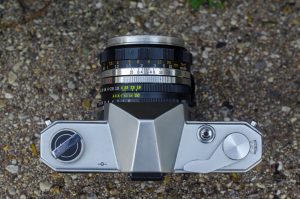
The control layout of the Kowa SET-R is nearly identical to every other focal plane camera made in Japan at the time. The folding rewind knob is on the left side of the top plate, the pentaprism is in the center of the camera, with the shutter release and rapid wind lever where you’d expect them to be. Even the exposure counter which on German cameras is often on the bottom or the back, is conveniently located right next to the wind lever.
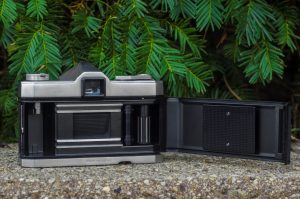
Loading film is an exercise in normalcy. Release the door latch on the side of the camera to open the door, load in a new cassette into the compartment on the left, thread the leader into the takeup spool on the right, advance the camera a couple of times and close the door. You could do this in your sleep. The image to the right of the film compartment of the SET-R looks like any other focal plane SLR with the exception of the angled capping plate in the film gate. This capping plate blocks light from exposing the film any time the reflex mirror is down and the shutter is open.

The only things on the bottom of the camera are the necessities, the battery compartment for the single PX25 battery, tripod mount, and rewind release button. In the image to the left, you can also see the release button for the lens mount. It is a metal button on the textured ring below and to the left of the upside down SEIKO logo.
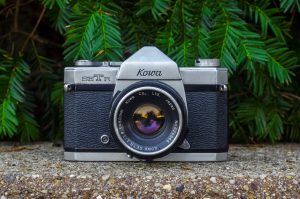
On the front of the camera, a PC flash sync port occupies the location where a traditional self timer lever would reside on a focal plane shutter, and your only hint at this being a leaf shutter camera is in the little switch around the lens mount at the 4 o’clock position. This little selector is the flash sync and self timer selector. The letters M and X are selected when using flash bulbs or electronic flashes, and V is used for the self timer.
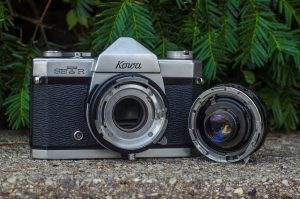
The SET-R has an interchangeable lens mount which allows for a variety of lenses to be attached. Kowa produced a total of 6 lenses to be used with the camera from an 8-element super wide angle 28mm lens all the way to a monster 200mm telephoto. The only lens available to me was the standard 6-element 50mm f/1.9 lens. The lens is a standard bayonet design with a small release pin located near the bottom of the lens mount.
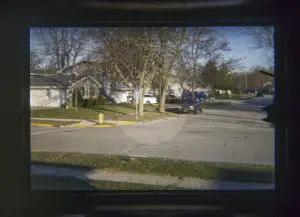
From inside the viewfinder, the focusing screen has prominent concentric Fresnel circles around a center circle to increase brightness. Within the circle is an outer ground glass ring and an inner microprism circle. On the right side of the viewfinder is the match needle for the exposure system. The Kowa SET-R has a fixed bracket in the center and a moving needle that you need to align within the two points of the bracket. It works very similarly to the one Pentax used on their Spotmatic SLRs of the 1960s.
When using the Kowa SET-R, you have what amounts to a pretty standard 1960s SLR. It has all of the right features, a TTL CdS meter, an easy to use interface, bright viewfinder, M and X flash sync at ALL shutter speeds, and a self timer.
Where the SET-R separates itself from other leaf shutter SLRs is that Kowa was able to design the lens opening just a bit larger than their German counterparts and release the fastest ever lenses available in a leaf shutter SLR. The standard lens on the SET-R is a bright f/1.9, and they managed to eek out an f/1.8 just in time for the SET-R2 from 1970. Kodak AG of Germany topped out with an f/1.9 lens on their later Retina Reflexes, but most other German companies like Voigtländer and AGFA typically equipped their cameras with f/2 and f/2.8 lenses. This is all even more impressive when you consider that Kowa sold their SLRs at a considerable discount to these other brands.
On paper, the Kowa SLRs really shouldn’t be that great. They were budget cameras by a company who didn’t have a lot of experience making 35mm cameras, they look kind of generic, and other than their fast lenses, their feature set didn’t boast anything not already available elsewhere. So what’s so special about this camera?
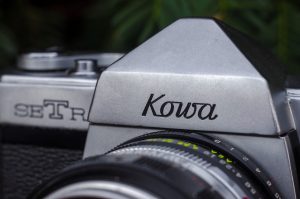
This is a “greater than the sum of it’s parts” situation. You have to feel this camera in your hands and appreciate the ever so slightly narrower camera. Weighing in at 811 grams without film but a battery installed, it’s not exactly light, but it doesn’t feel heavy either. The sounds the camera makes when the shutter fires is unlike any focal plane shutter. The symphony of sounds emitted from the camera’s shutter as the various metal pieces fly around with speedy precision is very cool.
I could probably use a thesaurus and come up with more words that are beyond my typical vocabulary in an attempt to explain why I like this camera, but I’ll just leave it as that for whatever reason, this camera connected with me and I thoroughly enjoyed using it. During my first roll through it, I felt that something was special about it and I couldn’t wait to see the results.
My Results
I loaded in a 36 exposure roll of fresh Fuji 200 and shot the entire roll in late summer 2017. My thought at the time was that this camera was aimed at the budget customer, so I used it in a general purpose manner, taking pictures of things that an amateur photographer might take pictures of. Before loading film, I did a couple of quick estimations of exposures using Sunny 16 and compared my calculations to what the meter in the viewfinder was recommending and they seemed pretty accurate, so I made the decision to rely on the camera’s meter for my recommended exposure settings.
I use mail order services like Dwayne’s Photo for my color film development, so whenever I have a completed roll of film, I try to remember to use a marker to write on the film what camera it came from and then I put it in a pile “to be developed later”. Once I have enough rolls to justify an order, I send them off all at once.

 Although I do my best to stay organized, there have been times where I mislabeled a roll of film or I simply forget to label it at all, and then I have to stare at the images and think “which camera was I using when I shot this”. In the case of the film from the Kowa SET-R, it was properly labeled, but when I saw the images, I was stunned. These looked spectacular! Out of a 36 exposure roll, every one was correctly exposed with great color, sharpness, and focus. This couldn’t have been a first roll through a 49 year old leaf shutter SLR, could it?
Although I do my best to stay organized, there have been times where I mislabeled a roll of film or I simply forget to label it at all, and then I have to stare at the images and think “which camera was I using when I shot this”. In the case of the film from the Kowa SET-R, it was properly labeled, but when I saw the images, I was stunned. These looked spectacular! Out of a 36 exposure roll, every one was correctly exposed with great color, sharpness, and focus. This couldn’t have been a first roll through a 49 year old leaf shutter SLR, could it?
Indeed it was. The images produced by this camera were some of the best I’ve shot from an inaugural roll. Even images where I took risks at minimum focus distance or strange angled shots turned out nice. I mentioned earlier that I trusted the meter for all of my images and that proved to be a wise decision as the meter clearly is working great after all these years. This is even more impressive when you consider this camera was designed for 1.35v Mercury batteries and I used a 1.5v silver-oxide battery. Some cameras do not like the voltage difference which can cause incorrect meter readings. Not the Kowa. Whether this camera has some type of “stepping circuit” to adapt the voltage, or I just got really lucky is anyone’s guess.
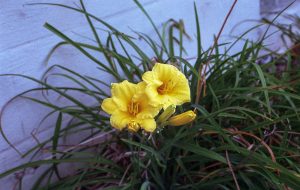
 Speaking of risks, while shooting the camera, I decided to get a little creative and see if I could get some extreme closeups with the camera by “freelensing” the camera. I set the lens to minimum focus and disconnected the lens and held it about 2-3 inches in front of the camera while doing my best to shield extra light from entering through the lens mount and I took a couple of shots of a flower from a couple inches away. The images to the left show the same exact shot, one at the camera’s minimum focus distance with the lens attached to the body, and the second with the lens being held in midair. There is another example of this in the gallery above of the purple flower where I used this same technique.
Speaking of risks, while shooting the camera, I decided to get a little creative and see if I could get some extreme closeups with the camera by “freelensing” the camera. I set the lens to minimum focus and disconnected the lens and held it about 2-3 inches in front of the camera while doing my best to shield extra light from entering through the lens mount and I took a couple of shots of a flower from a couple inches away. The images to the left show the same exact shot, one at the camera’s minimum focus distance with the lens attached to the body, and the second with the lens being held in midair. There is another example of this in the gallery above of the purple flower where I used this same technique.
Experimentation aside, when using this camera how it was designed produced excellent images. I know what I am about to say borders on heresy as guys like me obsess over and spend lots of money on camera bodies and lenses that are “better” than other models. A collector wouldn’t hesitate to drop well over a grand on a Leica M3 with a Summilux 50/1.4 lens on it, but if you shot a roll of film through that camera and compared it to say a run of the mill Nikon or Canon SLR with a 50/1.4 lens or even a Yashica Electro with it’s Yashinon 45/1.7 lens, would you REALLY see a difference? Even if you could, would it be worth the nearly 100x price premium of a Leica M3 and lens compared to that $10 garage sale Yashica?
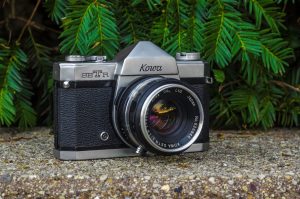
What I’m getting at here, is that just because a camera has a better reputation, or costs more, does not automatically make it better. Sure, you could buy 100 of these Kowa SLRs and none could work. Even with my example that does work, there’s no guarantee that it will continue to do so. And yeah, better cameras have more bells and whistles, or faster shutters, brighter viewfinders, or any other number of luxury items to justify their high price. But from an image quality standpoint only, it really doesn’t get any better than this. These images shot on the Kowa SET-R are some of the best that I’ve shot on 35mm. Further accentuating my point is that I used basic Fuji 200 film. This wasn’t fine-grain Ektar, Velvia, or AGFA Ultra. I bought this film at Walmart for $10.98 in a 4-pack.
I had a strong feeling I would like this camera when it first arrived. I thoroughly enjoyed using it, and when I saw the excellent images it produced, I can honestly say this is one of my favorite cameras. I will likely fast track a second roll of film in this camera just so I can use it again, and also to see if this first roll wasn’t just a fluke.
Related Posts You Might Enjoy
External Links
http://www.klassik-cameras.de/Kowa_SETR_eng.html
http://camerapedia.wikia.com/wiki/Kowa
http://www.collection-appareils.fr/x/html/camera-12468-Kowa_SetR.html

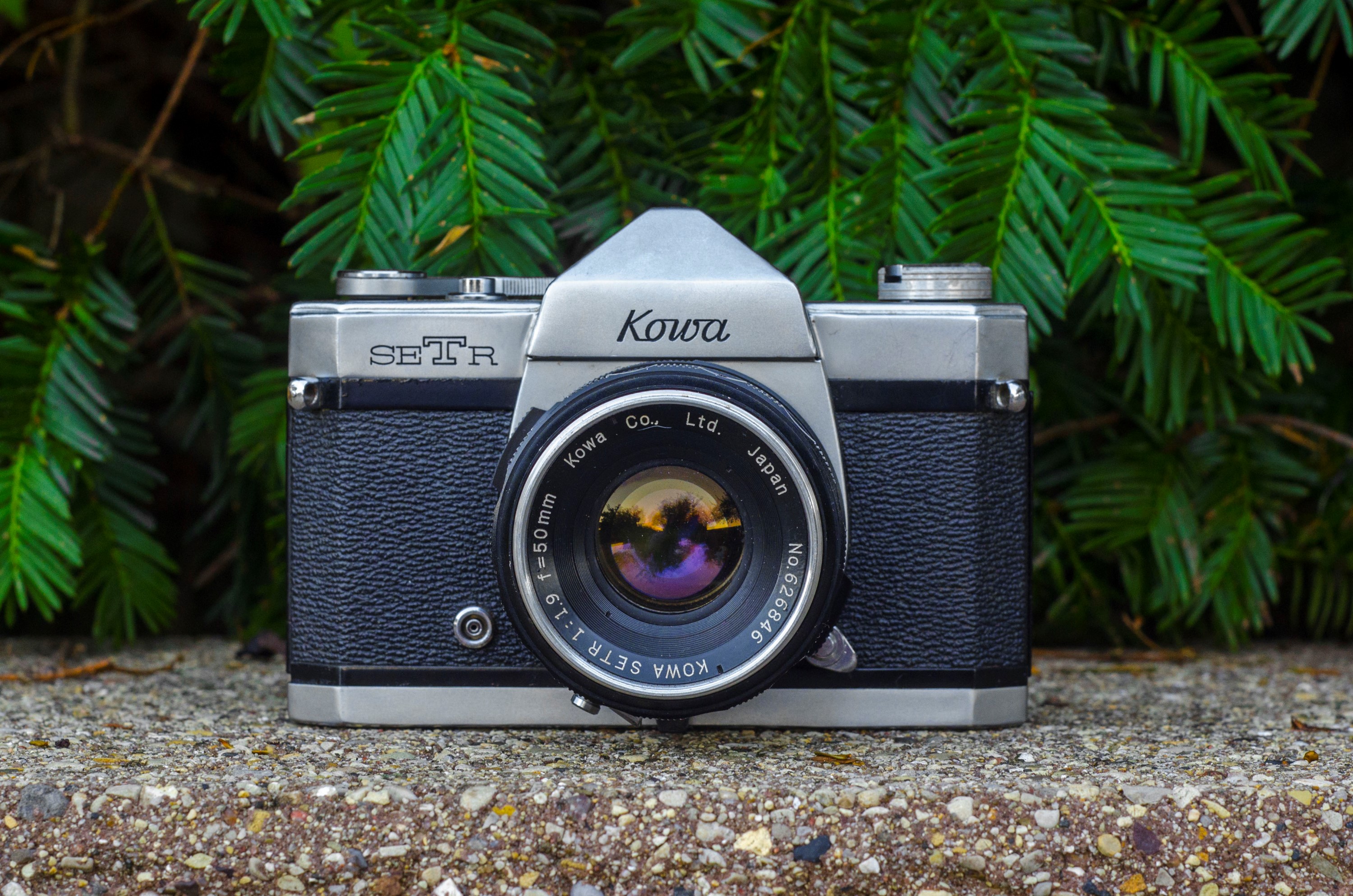
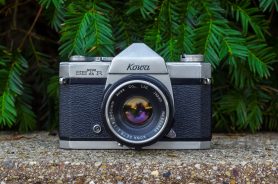
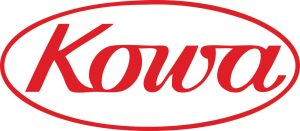












My first SLR was a Kowa SETR2 in the 1970s. I remember it did not have an interchangeable lens but I could be wrong. It took really good quality photos considering it was a budget camera. Your shots are amazing. They are just as good quality as modern digital cameras. Impressive. A very interesting review. Thanks Mike! Jeff Oliveira in CA.
I bought a Kowa SET-R in ‘71 and used it about one year before it went kaput. I got it from Wall Street Camera for 99 dollars which was all I could afford as a high school student. Photos taken with Panatomic X and processed in the school darkroom were outstanding, fully as good as those made with the school’s Pentax equipment. I loved that camera but it was not reliable. A nice paperweight!
Thats a shame that it died on you so soon. It’s really a marvel to hear stories like yours of cameras failing within a year, and then others who still work reliably more than 40 years later! This isnt my first Kowa SLR, and I quite like them all. This one though, gave me the best results and I can’t wait to shoot it again.
Hey Mike, thanks for writing this article! Your photos are beautiful and I’m glad you found a working body. I had a theory that most of the magic from this Kowa system is in the glass 🙂 After much trouble and lots of tinkering, I was able to build an EF adapter for these Kowa -R lenses. The images I’m getting on a FujiFilm 50R are stunning and unique. Not sure if its the coatings they used or the optical design (which seems pretty basic), but I instantly fell in love with the look. The flares are like nothing I’ve ever seen and the images scream analogue despite being shot on the latest digital sensor technology. Now I have bigger and better plans for my set 🙂 Thanks for the inspiration!
Very cool! I knew there had to be something special with these Kowa lenses! I’ll shoot you an email and if you’re willing to share your sample shots, I can add them to the review!
Hey Clint, Could you hint me at your process to build such an adapter?
I would really love to use these lens on modern camera.
A big thanks in advance 🙂
(and thanks to Mike for this nice article)
A little late to reply, but I’d love to share! Its rather simple. Find an old SetR or SetR2 that you are willing to scrap. Remove the entire lens mount by accessing the screws under the leather material. Do whatever it takes. All you are after is the part the lens attaches to and the iris adjustment ring. You can pull out all the stuff inside and remove the shutter adjustment ring altogether. Everything else gets ground off with a grinding wheel. In order to get minimum focus you need to remove metal until you can’t remove any more. Then, buy a reverse mount EF adapter and grind off the threads, leaving just the EF mount part. I had to sand that part down until it was paper thin in order to get infinity focus. Finally, epoxy those two parts together and you’re done. Or you can buy an adapter on eBay now for most mirrorless cameras 🙂
thanks 🙂
Thank you for a detailed review, impressive images.
Mike, concerning the PX625 1.35v battery requirements, what did you replace it with? Did you have any meter fluctuations with slightly higher voltages, such as a 675 air or a S476? I have an SET-R and can’t seem to get the meter down into the normal ranges…
Bob, I just used a generic alkaline PX625 that I bought from eBay. I found that it read a little high due to the increased voltage but it wasn’t significant enough to ruin the images. If your meter is way off, then it’s likely there’s a fault with your camera, and not the battery. Good luck!
Some people have no interest in low end cameras, but they made it possible for some on a budget to get started. My first camera was the original Kowaflex (non removable lens, no light meter, mirror locked up after taking photo until rewinding film). I was 15 years old and had used the family Voigtlander Vitessa just a little and also, just for curiosity, a Kodak Vigilants Six-16 we had that nobody ever used. I could barely afford the Kowaflex and cheap telephoto and wide angle add-on converters (the wide angle vignetted). But “looking through the lens” was like magic to me. I was hooked. I was in Heaven. Until shortly after I turned fickle and stepped up to a better camera. That was a Miranda DR which was certainly less cost than the top Nikon or Canon yet still had a removable finder and otherwise highly versatile. So that low end Kowaflex was an important step for me.
Hallo Mike!
Your article about the Kowa is very well made and really exhaustive. Congratulations!
I collect vintage SLR and own meanwhile 3 Kowas: 2 SE and 1 SET-R. I buy only defective cameras and try to repair them to get them working. The Kowas costed very little money as they had severe problems . So they had to be taken completely apart, including the shutter.
I had to invest many hours to get them fixed but they are now in very good order, except on one SE where the meter is dead .(The Galvanometer is dead and not repairable). On the other two I calibrated the meter to my Gossen Profisix and are perfect.
After all I can say they are real quality cameras, very sturdy and well built. If you study them closely, they are quite easy to repair.
As they are ready now, I get a vew films through and see the results.
If you let me have your e-mail adress I can send you some fotos from the repairwork, how they look when taken apart .
Good luck and all the best,
Herb Reikers
I purchased a Kowa SE and SET. The SE was not in functional condition, but I received an amazing camera strap. The SET is fully functional and the battery has been replaced and the meter appears on be functioning.
I have a converted Kowa lens to M42 which prompted me with purchase this camera in the first place. Now time to take some pictures.
You have a typo under the ad for the Kowa Six. You wrote Kodak.